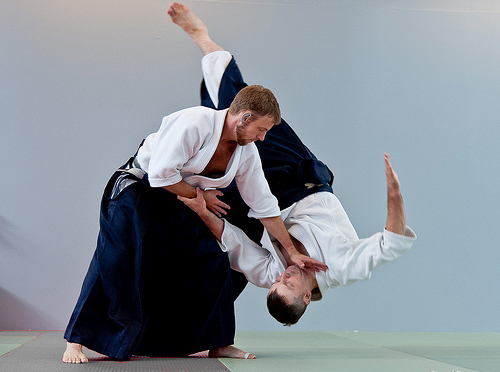Product Aikido
Product Aikido
Photo Credit: Sigurd R
I wrote a post some time about Doctrine, although in that case I was writing about business, and the potential value to an organisation in defining just what it means by the term “business”.
“I reject any doctrine that does not appeal to reason and is in conflict with morality.”
~ Mahatma Gandhi
Since then I have been working on a first draft of an exemplar of a “Doctrine for Product Development”, which I have named “Product Aikido” (presently, a document of some seventy-seven A5 pages). My motive for this has been the belief that there is much value in (product) organisations having a shared, common understanding of what product development is, and how it is conducted.
Note: The colophon at the end of the document explains a little more about the choice of name, amongst other things.
I offer this first draft here for your kind consideration. Any feedback, questions, comments or suggestions you might have for its improvement will, as always, be most welcome.
Excerpt
“The essence of product development is an intense and ongoing struggle between organising intent and entropy. Organising intent is the will of the company, manifest in the actions of its product development people, bent on meeting the goals of the company through the creation and evolution of products and product features.”
– Bob
Further Reading
Product Aikido – The Exemplar Doctrine


Awesome. Thanks, Bob!
Started to read the first few pages—promising 🙂
Bob,
Thank you for sharing! As a philosophical work exploring various facets of the Art of Product Development it good. But my respective half-brains were still searching at the end of a quick flick-through review:
My right brain was searching for diagrams, pictures, analogies, story-boxes.
My left brain found a good structure and set of ideas, but did not find much about the main human motivators of Autonomy, Mastery and Purpose (Pink et al.) Nor about the context of the book (who is the client, what do they develop, how do they compete, what are their main differentiators).
I am not an Aikido practitioner – but the idea of a smaller player using the force of a (larger) competitor to throw them off balance is an interesting one for me – particularly with a couple of my smaller clients. I would like to explore this particular idea further. How could I design-in such tactics in the movement of Product Development? These are the sorts of questions I would love to go deeper in answering.
Best,
Lorne
Many of us offended by the traditional use of masculine nouns and pronouns now use the feminine in the same way. Explaining that usage up front makes good sense to me. When equality of assumption has taken place, we can use either.
Never mistake a clear view for a short path.
Whatever can you mean by “a clear goal”. Product development by its very nature has a plentitude of goals. In practice, we must agree on at most as many goals as you have fingers and thumbs. Most important is that the stakeholders, or their surrogates, must agree on exactly how progress toward those goals will be measured.
What magic do you have to know what disruptions and discontinuities could possibly be used to advantage?
What scale of nimble are you attempting? In my experience a team with a limited number of goals may be able to accomplish a step in a week (some even in a day or an hour), but allowing times of reckoning to extend even to a month adds substantial costs in efforts wasted because of the lack of the fastest possible learning of what’s really true.
But how to pick the best next step? Impact estimation. Say we have six proposals for the next step for some team. List them down the side while the goals are listed along the top. Spend only a minute or two guessing how much progress will this step make toward this goal. Even with ten goals, this should take less than two hours. Now the next step to undertake will be fairly clear. It’s OK if you chose the second best; that’s likely good enough.
Enough for now from me.
Have you thought to send this to the authors of your favorite books on the topic? They could all ignore it completely, but if even one responds, I’d wager the value will exceed the cost of the effort to bring them in.
i’m getting a 404 on the link to the document. has it been taken off of dropbox?
Sorry but yes. Gone but not forgotten. May come back in the future (no guarantees, mind).
I have updated the link to point to the now WordPress-hosted version of the document.
Having spent many years practising Aikido, I cringe inwardly every time I hear the “it’s a lot like dancing” quote.
Did you read the book?